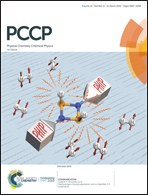A new method to analyze and understand molecular linear and nonlinear optical responses via field-induced functions: a straightforward alternative to sum-over-states (SOS) analysis†
Abstract
The sum-over-states (SOS) method allows the computation of polarizabilities and hyperpolarizabilities additively from the contributions of different electronic excited states in a given molecule or cluster. Subsequent analysis of the main excited configurations contributing to the relevant excited states allows characterizing the orbitals involved in the linear and nonlinear optical response. Unfortunately, the chemically relevant information that can be obtained by SOS is hindered by a series of methodological and computational drawbacks. Among these drawbacks, we can highlight the high computational cost, problems arising from nonconvergent series and errors caused by the inaccurate description of excitation energies and/or higher excited state matrix elements. For this reason, coupled-perturbed schemes are currently widely used to determine the NLO potential of molecules and materials. However, such a choice limits the amount of intuitive chemical information that, on the other hand, can be retrieved by a successful SOS computation. In this work, we present and discuss a novel computational strategy that offers the means to extract the useful chemical insights from a coupled-perturbed calculation at almost negligible extra computational cost providing a transparent picture about orbital contributions to the properties of interest. The proposed method is based on the generation and further analysis of field-induced orbitals, FIOs, from the analytic or numerical derivatives of the dipole moment. Orbital symmetry rules are derived using group theory and the method is tested for a series of small and medium size systems.



 Please wait while we load your content...
Please wait while we load your content...